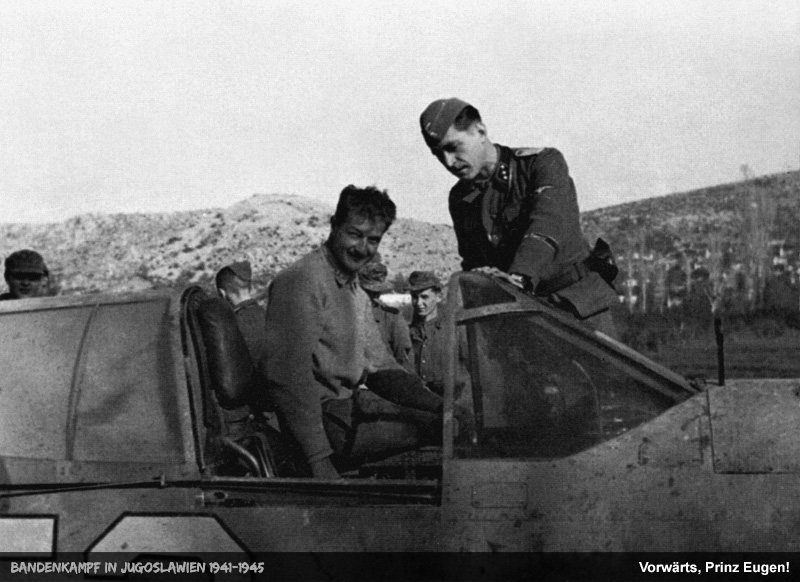
Captain Walter M. Schwartz, a downed US pilot, posing smiling in his Curtiss P-40F, next to SS-Untersturmführer Karl Schaeffer, an officer of the 14th Regiment, "Prinz Eugen" Division. Walter Marshall Schwartz Jr. was born in Philadelphia, a successful businessman and president of the Proctor Electric Company, who after the outbreak of World War II volunteered in the British – and then (after his homeland entered the war) also in the US Air Force. He was commander of the 65th Squadron of the 57th Fighter Group, which, on 12 November 1943, flew over Čapljina on a mission to bomb the military airfield in Mostar. On the return flight, the unit attacked the railway station in Čapljina, and the Anti-Aircraft Battalion of the "Prinz Eugen" Division, which was located nearby. In this dramatic combat, the aircraft of captain Schwartz was hit, and it landed in the village of Višići, near Čapljina (luckily stopping only 14 m from a row of poplars). The US pilot was found the next day, near his aircraft, where he hid and spent the night. He was taken care of by Karl Schaeffer, one of the (apparently) honourable officers of this otherwise infamous SS division. Schwartz was fed, bathed and shaved, and his clothes were cleaned. The two officers then drove to the downed aircraft, where the German asked the American to demonstrate how the machine guns in his Curtiss work. The prisoner accepted, asked that the soldiers move away from the machine so that they would not get hurt, pushed the button and fired an impressive burst; this photograph was taken on that occasion too. Schwartz was soon sent to the German Air Force, from where he was transferred to a POW camp near Barth [Stalag Luft I], in which he saw the end of the war as well. As he was leaving, he left a message of gratitude for the good treatment to Schaeffer. Both officers survived the war; Schaeffer later lived and worked in Brazil, and Schwartz continued to lead the old company (which, during the war, also made parts for the aircraft in which he was shot down). The brave captain, as the SS officer called him, died at the age of 75. He left behind two daughters and six grandchildren.
Text: Ivan Ž.
Photographer: unknown, 7th SS Volunteer Mountain Division "Prinz Eugen".
Date: 13 November 1943.
Location: Višići (district of Stolac), Yugoslavia.
Original caption: unknown.
File source: Otto Kumm, "Vorwärts, Prinz Eugen!" (p. 130/131).
NOT ALLOWED: removing source credits from the files – using text without crediting the original author – using files and information for political propaganda and commercial purposes.
Kapetan Valter M. Švarc, oboreni američki pilot, pozira nasmešen u svom Kertisu P-40F, pored SS-unteršturmfirera Karla Šefera, oficira 14. puka divizije "Princ Ojgen". Valter Maršal Švarc (mlađi) bio je rodom iz Filadelfije, uspešan biznismen i predsednik kompanije Proktorovi električni aparati [Proctor Electric], koji se po izbijanju II svetskog rata dobrovoljno prijavio u britansko – a zatim (ulaskom svoje domovine u rat) i u američko ratno vazduhoplovstvo. Bio je komandir 65. eskadrile 57. lovačke grupe, koja je 12. novembra 1943. godine letela preko Čapljine sa zadatkom da bombarduje vojni aerodrom u Mostaru. U povratku, jedinica je napala i železničku stanicu u Čapljini, i protivavionski divizion divizije "Princ Ojgen", koji se nalazio u blizini. U ovoj dramatičnoj borbi pogođen je avion kapetana Švarca, koji je potom aterirao u selo Višiće, nedaleko od Čapljine (srećno se zaustavivši na samo 14 metara od jednog drvoreda topola). Američki pilot je pronađen tek sledećeg dana, u blizini svog aviona, gde se bio sakrio i prenoćio. Za njega se pobrinuo Karl Šefer, jedan od (po svemu sudeći) časnih oficira ove inače po zlu poznate SS-divizije. Švarc je nahranjen, okupan i obrijan, i odeća mu je očišćena. Dvojica oficira su se zatim odvezla do oborenog aviona, gde je Nemac Amerikanca pitao da pokaže kako funkcionišu mitraljezi u njegovom Kertisu. Zarobljenik je prihvatio, zatražio da se vojnici udalje od mašine da ih ne bi povredio, pritisnuo dugme i ispalio jedan impresivni rafal; tom prilikom je nastala i ova fotografija. Švarc je ubrzo prosleđen nemačkom ratnom vazduhoplovstvu, odakle je prebačen u zarobljenički logor kod Barta [Stalag Luft I], u kojem je dočekao i kraj rata. Na rastanku, Šeferu je ostavio poruku zahvalnosti na dobrom tretmanu. Oba oficira su rat preživela; Šefer je kasnije živeo i radio u Brazilu, a Švarc nastavio da vodi staru kompaniju (koja je, za vreme rata, pravila delove i za avion u kojem je oboren). Hrabri kapetan, kako ga je nazvao SS-oficir, preminuo je u 75. godini života. Za sobom je ostavio dve ćerke i šestoro unučadi.
Tekst: Ivan Ž.
Fotograf: nepoznat, 7. dobrovoljačka brdska SS-divizija "Princ Ojgen".
Datum: 13. novembar 1943.
Mesto: Višići (srez Stolački), Jugoslavija.
Originalni natpis: nepoznat.
Izvor fajla: Otto Kumm, "Vorwärts, Prinz Eugen!" (str. 130/131).
NIJE DOZVOLJENO: uklanjanje naziva izvora sa fajlova – korišćenje teksta bez navođenja izvornog autora – korišćenje fajlova i informacija u političko-propagandne i komercijalne svrhe.









